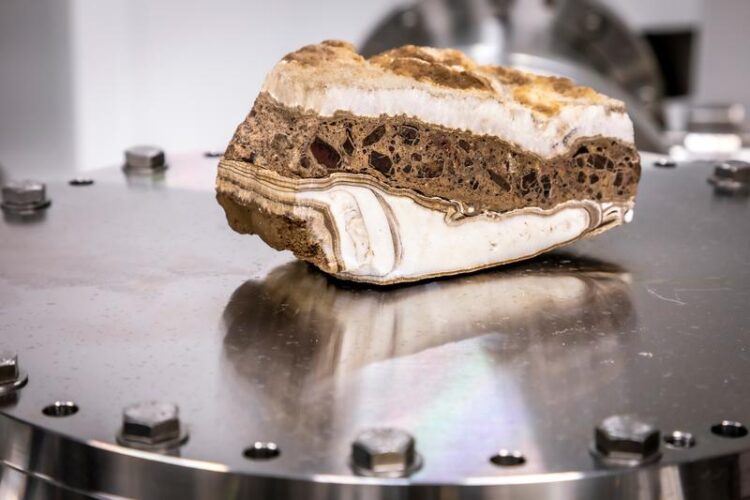New sediment archive for historical climate research

The research activities focused on the so-called Erzbergit, a sedimentary rock consisting of calcium carbonate (white layer) and here crossed by dolomite (brown layer).
www.lunghammer.at
© Lunghammer - TU Graz
TU Graz researchers discover new sediment archive for historical climate research.
Geological investigations of low-temperature young deposits on the Styrian Erzberg provide paleoclimatology with new data on the earth’s history and its development.
How has the climate changed in the course of the earth’s history? Which climatic processes have influenced the earth and its atmosphere? Paleoclimatology seeks answers to such questions in order to better understand climate changes and to derive forecasts for future climate scenarios. So-called sedimentary archives serve as a basis for this.
They are rock deposits whose components and composition provide information about the temperatures and climatic conditions at the time of their formation. Correspondingly recent geological deposits provide information about the climate development in the recent history of the earth since the last ice age 20,000 years ago. Compared to widespread seawater deposits, however, sedimentary archives on the mainland – such as in the Alpine region – are very rare.
New data for palaeoclimate research
An international consortium led by the Institute of Applied Geosciences (IAG) of Graz University of Technology has now made a sensational discovery in this area. In a publication for Communications Earth and Environment, the group presents newly discovered, geologically very young deposits on the Styrian Erzberg, whose importance as a sedimentary archive for paleoclimate research was investigated for the first time. “The fact that we have now found such young geological deposits, which are usually only found in marine sedimentary archives, in a continental sedimentary archive is sensational and a treasure trove of data for climate research,” explains the first author of the study, Andre Baldermann of the IAG.
Low formation temperature and recent deposition age
Specifically, these are sedimentary fillings of faults and fractures which consist of the carbonate minerals dolomite, aragonite and calcite. It is known that the carbonate mineral dolomite crystallizes when seawater evaporates, which in turn requires high temperatures. Baldermann and his team have now been able to show for the first time that the mineral can also form at temperatures between zero and twenty degrees Celsius – there has been no absolute data on this so far.
In addition, the researchers discovered that these are comparatively geologically young minerals that were formed shortly after the last ice age about 20,000 years ago in a non-marine (continental) depositional area. Baldermann: “This is a novelty, as recent formations of the mineral have been restricted almost exclusively to seawater deposits until now.”
Material analysis through multi-method approach
The entire range of geological investigation methods was used in the analyses. The rock samples were microscopically described and systematically classified. The mineralogical composition was determined by X-ray diffraction and the chemical properties were defined using high-resolution electron microscopy. For age dating and temperature reconstructions, the samples were analysed elementally and isotopically using state-of-the-art mass spectrometry. “The large number of results allowed us to draw conclusions about water flow, water composition, mineral growth and formation temperatures,” says Baldermann.
Benefits for climate research
“Climate research works mainly by analysing marine sediments, because we have archived a large number of sediments (marine sediments, note) over the entire course of the earth’s history. Continental sedimentary archives are rare and are only very rarely considered. Their deposits usually provide only little information about old environmental conditions,” says Baldermann. He is convinced that the newly published data on the deposits on the Erzberg will remedy this situation and provide new perspectives on climate development of the recent past.
This research area is anchored in the Field of Expertise “Advanced Materials Science”, one of the five strategic foci of TU Graz.
The work was supported by NAWI Graz Central Lab Water, Minerals and Rocks, by the mining company VA Erzberg and by researchers from the Universities of Vienna and Graz. Financial resources were made available from the European Regional Development Fund (ERDF).
Cooperation partners:
At TU Graz: Institute of Applied Geosciences (Lead), Institute of Technology and Testing of Construction Materials
Futher scientific project partners: Geological Institute of ETH Zurich, Institute of Environmental Physics at the University of Heidelberg, Earth Observatory and Asian School of Environment of Nanyang Technological University
Corporate partners: JR-AquaConSol GmbH, Geoconsult ZT GmbH
Wissenschaftliche Ansprechpartner:
Andre BALDERMANN
Dr.rer.nat. M.Sc.
TU Graz | Institute of Applied Geosciences
Telefon: +43 316 873 6850
E-Mail: baldermann@tugraz.at
Originalpublikation:
Fracture dolomite as an archive of continental palaeo-environmental conditions
Andre Baldermann, Florian Mittermayr, Stefano M. Bernasconi, Martin Dietzel, Cyrill Grengg, Dorothee Hippler, Tobias Kluge, Albrecht Leis, Ke Lin, Xianfeng Wang, Andrea Zünterl, Ronny Boch
Nature Communications Earth and Environment
Doi: 10.1038/s43247-020-00040-3
Weitere Informationen:
https://www.tugraz.at/en/research/fields-of-expertise/advanced-materials-science… (Field of Expertise “Advanced Materials Science”)
https://www.nawigraz.at/en/research/infrastructure/central-labscore-facilities/ (NAWI Graz)
https://www.tugraz.at/institute/iag/home/ (Institute of Applied Geosciences)
Media Contact
All latest news from the category: Earth Sciences
Earth Sciences (also referred to as Geosciences), which deals with basic issues surrounding our planet, plays a vital role in the area of energy and raw materials supply.
Earth Sciences comprises subjects such as geology, geography, geological informatics, paleontology, mineralogy, petrography, crystallography, geophysics, geodesy, glaciology, cartography, photogrammetry, meteorology and seismology, early-warning systems, earthquake research and polar research.
Newest articles

Parallel Paths: Understanding Malaria Resistance in Chimpanzees and Humans
The closest relatives of humans adapt genetically to habitats and infections Survival of the Fittest: Genetic Adaptations Uncovered in Chimpanzees Görlitz, 10.01.2025. Chimpanzees have genetic adaptations that help them survive…

You are What You Eat—Stanford Study Links Fiber to Anti-Cancer Gene Modulation
The Fiber Gap: A Growing Concern in American Diets Fiber is well known to be an important part of a healthy diet, yet less than 10% of Americans eat the minimum recommended…

Trust Your Gut—RNA-Protein Discovery for Better Immunity
HIRI researchers uncover control mechanisms of polysaccharide utilization in Bacteroides thetaiotaomicron. Researchers at the Helmholtz Institute for RNA-based Infection Research (HIRI) and the Julius-Maximilians-Universität (JMU) in Würzburg have identified a…



